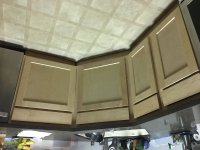Just finishing the lower cabinet face frames and doors on my kitchen, using hard maple, and I am getting a little weary of sanding the rails and styles flush... I apparently suck at getting the router bits to line up (using the Sommerfeld Shaker set, plywood inserts), so I've always got a 1/32" or so lip to sand out. The stock is all planed at the same time, so it isn't a board thickness issue, and I am following Sommerfeld's recommendations of using the rubber grommet in the collet to maintain the bit height.
So my question - would a plane be a good thing to use to get the surfaces level, even with the grain changes? Right now I'm having to sand from 120/180/220 to get the surfaces even and ready for finish. My DeWalt 735 planer with helical head gives me a good enough surface on its own that I can get by with a quick 220 pass, so its annoying to have to knock the whole face/back down to 120 and bring it back up.
I have a Veritas Bevel-up Smoother (I assume this would be the choice?), a Lie Nielsen Bevel up jack, and a Veritas bevel up jointer. I'm using the Veritas jointer/fence on the edges and end grain with good results. I tried the Veritas BUS briefly and wasn't happy with what I was seeing... Attached is a pic of what I'm working on... (not sure why the preview is upside down, sorry)
So my question - would a plane be a good thing to use to get the surfaces level, even with the grain changes? Right now I'm having to sand from 120/180/220 to get the surfaces even and ready for finish. My DeWalt 735 planer with helical head gives me a good enough surface on its own that I can get by with a quick 220 pass, so its annoying to have to knock the whole face/back down to 120 and bring it back up.
I have a Veritas Bevel-up Smoother (I assume this would be the choice?), a Lie Nielsen Bevel up jack, and a Veritas bevel up jointer. I'm using the Veritas jointer/fence on the edges and end grain with good results. I tried the Veritas BUS briefly and wasn't happy with what I was seeing... Attached is a pic of what I'm working on... (not sure why the preview is upside down, sorry)

